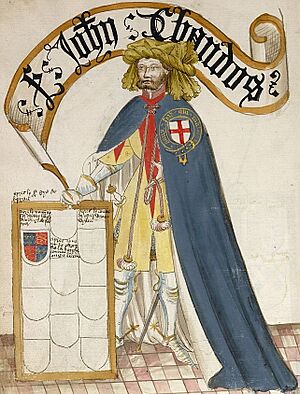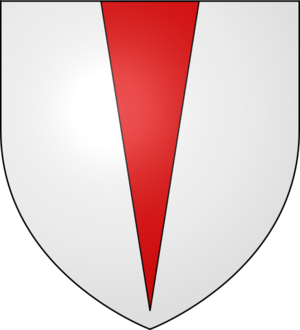John Chandos facts for kids

Sir John Chandos (born around 1320 – died December 31, 1369) was a famous English knight from Derbyshire. He was a close friend of Edward the Black Prince, who was the son of the King of England. Sir John was also one of the first members of the important Order of the Garter in 1348.
Even though he wasn't born into a noble family with a fancy title, Chandos was known as a very smart and skilled military leader. The historian Jean Froissart called him "wise and full of devices." Many believe he planned the winning strategies for three big English victories during the Hundred Years War: the Battle of Crécy, the Battle of Poitiers, and the Battle of Auray. His death in a small fight was a sad event for both sides of the war.
Contents
Early Life and Beginnings
John Chandos came from a family of landowners in Radbourne, Derbyshire. His father was Sir Edward Chandos. Like many young men of his time, he trained to be a knight. He quickly showed great skill in fighting and leadership.
Sir John's Military Adventures
Sir John Chandos was involved in many important battles. Before the Battle of Sluys, King Edward III of England sent Chandos and two other knights to check on the French fleet. They found the French ships packed together, blocking the entrance to the Zwin channel.
Chandos played a key role at the Battle of Crécy. He was also the main strategist for Edward, the Black Prince, at the Battle of Poitiers in 1356. His plans helped the English win these major battles.
In 1360, King Edward III made Chandos a knight banneret. This special title allowed him to carry his own banner in battle, showing he was a high-ranking commander. He was also given the title of Viscount of Saint-Sauveur-le-Vicomte in France.
On September 29, 1364, Chandos led the forces of Duke John de Montfort to victory at the Battle of Auray. This win ended the Breton War of Succession and made John de Montfort the Duke of Brittany.
For his great service, Chandos was given more important roles. He became the lieutenant of France and the vice-chamberlain of England. He also became the constable of Aquitaine during the Hundred Years' War. However, he later disagreed with Edward about taxes in a region called Guyennois and decided to retire to his home in Normandy.
The Last Battle: Sir John's Death
In 1369, the French army started winning back land. King Edward had to call Chandos back to duty. Sir John was then made the seneschal of Poitou, a region in France. He moved to Poitiers to help stop the French from taking over more areas.
Some French knights had taken control of La Roche-Posay and Saint-Savin, which were close to Poitiers. Sir John planned a surprise night attack to take back the abbey of Saint-Savin.
But the plan didn't work out. Chandos's forces thought they had been spotted and decided to retreat towards a bridge over the Vienne River at Lussac-les-Châteaux. Coincidentally, the French knights were also heading to the same bridge. The two groups met there.
During the fight, Sir John slipped on the icy ground because of his long coat. A French squire named James de Saint-Martin struck him with a lance, hitting him below the eye. Chandos's uncle, Edward Twyford, bravely protected his wounded nephew. One of Chandos's own squires wounded James Saint-Martin, who died a few days later.
Sir John Chandos was carried on a large shield to the nearest English fortress, Morthemer. He suffered through the night and died on December 31, 1369, or early on January 1, 1370. He was about 55 years old.
Sir John's Lasting Impact
When news of Sir John's death reached King Edward III of England and the Black Prince, they were very sad. Chandos was not just a great fighter; he was also a smart leader and a good politician.
A special monument, called a cenotaph, was built to mark the spot where he fell. This monument is still there today in a garden in Mazerolles, France. It was moved once because of river flooding.
People on both sides of the war mourned his death. It is said that Charles V of France, also known as "Charles the Wise," believed that if Chandos had lived, he would have found a way to make lasting peace between France and England. The historian Froissart also wrote that many French knights regretted his death, saying he was so wise that he could have helped bring peace. Froissart also said that Chandos was one of the most polite and virtuous English knights in a hundred years.
Chandos's Herald
Sir John Chandos had his own official messenger, known as Chandos Herald. This herald wrote an important poem called The Life of the Black Prince. The poem tells about many of the Black Prince's adventures during the Hundred Years' War, including parts of the Castilian Civil War and the battles of Crécy and Poitiers.
Sir John in Stories and Games
Sir John Chandos has appeared as a character in many books and video games:
- He is a character in Arthur Conan Doyle's historical novels The White Company (1892) and Sir Nigel.
- He appears in the video game Bladestorm: The Hundred Year War as a close guardian of Edward, the Black Prince.
- He is also a character in the Dragon Knight book series by writer Gordon R. Dickson.
- In TOMMY Ohtsuka's manga Hawkwood, John Chandos is shown as Edward the Black Prince's mentor.




